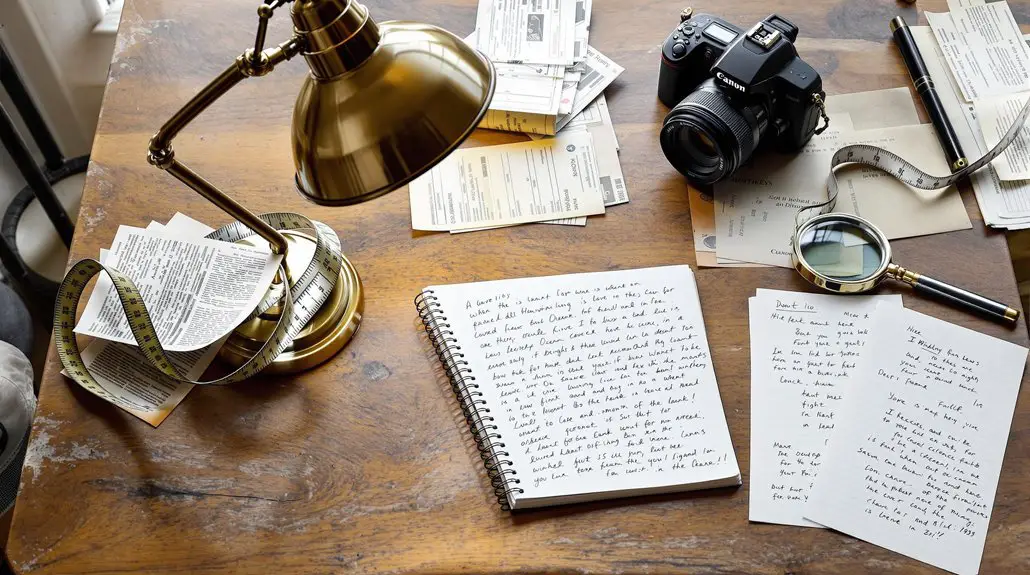To create detailed provenance for your vintage items on eBay, you'll need to gather concrete evidence of authenticity and history. Start by documenting your item's background through receipts, certificates, and historical records. Take high-quality photos from multiple angles, including close-ups of maker's marks, labels, and any wear patterns that verify age. Research similar items through auction databases and price guides, then consult experts or antique publications for professional validation. Tell your item's story engagingly in the listing, connecting its historical significance to potential buyers. There's so much more to uncover about maximizing your vintage item's credibility and value.
Defining Your Item's Historical Background
A well-documented historical background is essential when selling vintage items on eBay. You'll want to dive deep into the cultural significance of your piece, understanding how it fits into the broader tapestry of its era.
Think about what was happening in the world when your item was created – maybe it's a mid-century modern lamp that emerged during the space race, or a Victorian brooch that reflected the romantic sensibilities of its time. Just like when an ancient pair of Levis sold for $46,000, your vintage item's historical context can dramatically impact its value.
As you're building your item's story, you'll need to connect it to specific artistic movements and social trends that influenced its design. For instance, if you're selling an Art Deco bracelet, you'd want to highlight how it embodies the roaring twenties' love of geometric patterns and bold statements.
Remember to explore any historical events that might've shaped your item's creation or use. The more you can paint a picture of the world your item came from, the more collectors will appreciate its significance.
Don't forget to look for connections between your piece and the cultural movements that defined its period – these details often make the difference between a simple listing and one that truly captures buyers' imagination.
Documenting Previous Ownership Records
Through careful documentation of ownership records, you'll establish the legitimacy and value of your vintage items on eBay.
Start by gathering every receipt, invoice, and certificate of authenticity you can find – these are your golden tickets to proving an item's history. Tag identification can further enhance the credibility of what you are selling.
Don't forget to collect those gallery records and exhibition catalogs, which can really make your listing shine.
When you're tracing your item's journey, you'll want to dig deep into both public and private records.
Think of yourself as a detective, piecing together the story of who owned your treasure before you.
Those old auction catalogs and dealer records aren't just dusty paperwork – they're valuable pieces of your item's puzzle.
While you're at it, take advantage of online resources like auction databases and the Art Loss Register to verify your item's authenticity and ascertain it hasn't been reported stolen.
Remember to verify all your documents carefully, making sure signatures are legible and descriptions match your item perfectly.
If possible, get original copies rather than photocopies – they carry more weight with serious collectors.
Maintaining detailed documentation helps protect against purchasing or selling unintentional stolen goods and ensures compliance with antiquities laws.
Research Methods and Expert Consultation
Building upon your documented ownership records, proper research methods and expert consultation will strengthen your vintage item's credibility on eBay.
You'll want to start by diving into online price guides and market analysis tools, which can help you understand current trends and establish competitive pricing. Trust me, I've seen sellers who skip this step struggle to make sales, while those who do their homework often thrive. For instance, understanding the price range for similar vintage items can give you a solid advantage. Utilizing a dedicated Marketplace Fee Calculator can provide clarity on potential fees that might affect your pricing strategy.
When you're dealing with particularly valuable or unique pieces, don't hesitate to seek professional appraisals. While it might cost you a bit upfront, having an expert's opinion can greatly boost your item's perceived value and trustworthiness. You'll want to look for appraisers who follow USPAP standards and have relevant certifications in your item's category.
Make sure you're also taking advantage of specialized resources like the Arts Department's reference materials and online authentication services. Antique Collecting magazine provides expert-written articles that can help validate your item's authenticity.
While you're researching, document everything you find about your item's historical significance, market relevance, and unique characteristics.
Building Trust Through Visual Evidence
Visual evidence stands at the forefront of establishing trust with potential eBay buyers for your vintage items. You'll want to start by capturing high-quality images that showcase your piece from every conceivable angle, ensuring you're using proper lighting and a clean, distraction-free background that lets your item's details shine through.
When you're photographing your vintage treasure, don't shy away from those tiny imperfections – they're actually your allies in building credibility. Include clear shots of any marks, stamps, or labels, and zoom in on unique features that help authenticate your piece. Additionally, consider documenting the item's preworn condition as it may influence buyer perception and value. Including visual evidence of your item's seller earnings policy can also enhance buyer confidence.
If you've got documentation like certificates of authenticity or original receipts, you'll definitely want to showcase these too – they're worth their weight in gold when it comes to establishing provenance.
Remember to maintain consistency in your presentation, as if you're telling a visual story. Start with overview shots, then guide your potential buyers through a journey of exploration with detailed close-ups.
When you're transparent about both the highlights and the flaws, you're not just selling an item – you're building a reputation that'll serve you well in future sales. Utilizing an eBay Fee Calculator can also help you better understand your potential earnings after fees, further enhancing your trustworthiness as a seller.
Effective Storytelling on Ebay Listings
While compelling photos lay the groundwork for your vintage item's authenticity, the art of storytelling will transform your eBay listing from a simple product page into an engaging narrative that captivates potential buyers.
You'll want to craft a story that resonates with your audience's emotions while staying true to your item's history. Start by understanding who's likely to bid on your vintage piece – whether they're collectors, history enthusiasts, or design lovers.
Then, weave your item's unique tale using personal pronouns and relatable language that connects directly with these potential buyers. Don't just list features; explain how this vintage treasure solved problems in its era and how it might enhance the buyer's life today.
Remember to keep your narrative authentic and concise. If your antique chair witnessed decades of family gatherings, share that story, but don't embellish with fictional details.
Focus on genuine details that make your item special, like the patina that developed over years of use or the craftsman's mark that reveals its origins. Your goal isn't just to sell an item – it's to pass along a piece of history that buyers can connect with emotionally.




